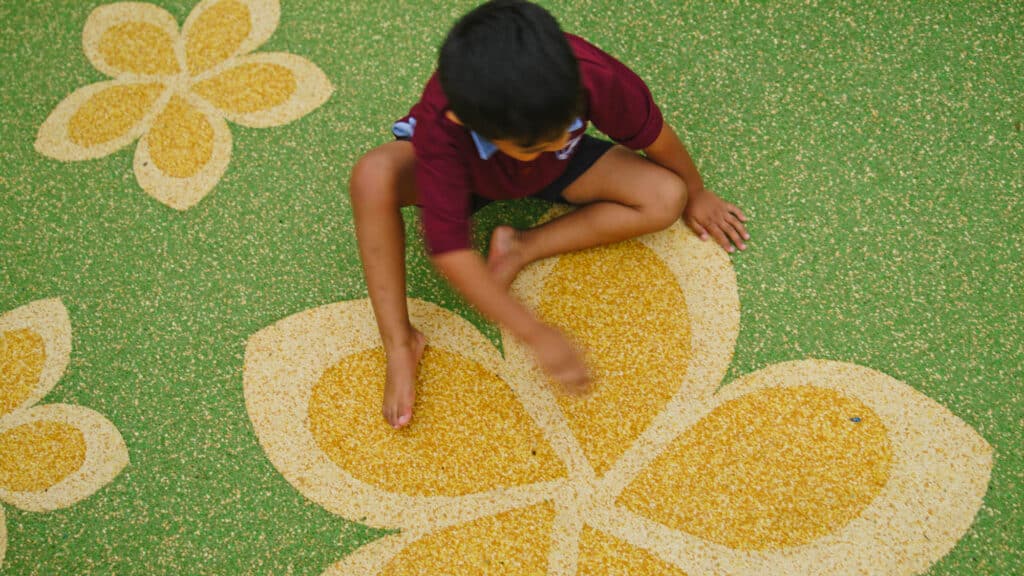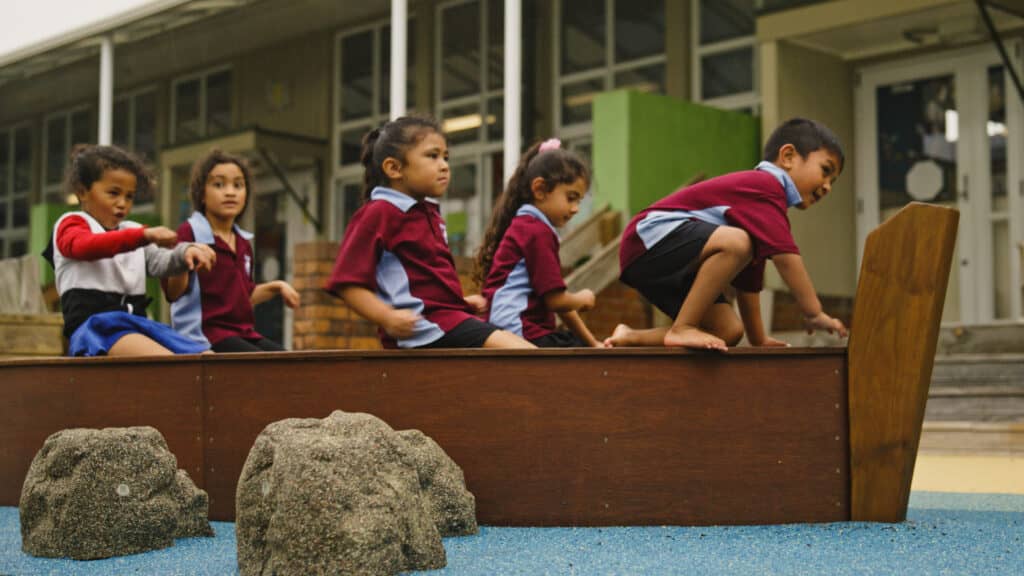The process of designing a playground can be very complex. That is why we have compiled 50 ways to improve your school playground spaces. This article is perfect if you plan and create a budget for your next school project or are just looking for ideas for a future upgrade.
Wonderful Walls: Transforming Vertical Spaces
Community Murals:
Involve your students and local artists in designing and creating colourful murals. This not only beautifies your walls but also nurtures creativity.
Interactive Chalkboard Wall:
Cover a wall with chalkboard paint, providing a space for creativity, self-expression, or outdoor class activities. This dynamic feature changes with the student’s imagination, stimulating artistic, mathematical, or linguistic play.
Rock-Climbing Wall:
Convert a bare concrete wall into a fun, engaging space by bolting on some climbing holds. Ensure the wall is safe and the grips are set for side-to-side climbing.
Green Walls:
A vertical garden beautifies dull walls and helps students appreciate the environment. Simple materials like timber and recycled plastic bottles are all you need.
Musical Walls:
Add a sprinkle of rhythm to your school with a music wall. Old pots, pans, chimes, and xylophones offer a chance to explore melody and beat.
Bullseye Games:
A simple target on the wall can become the foundation for countless games. Add a tennis or soccer ball, and the students can handle the rest!
Mirror Play:
A mixture of regular and distorted mirrors can add a fun twist to playtime, sparking imagination and science discussions.
Inspirational Quote Wall:
Create a mural of inspirational quotes. It provides aesthetic beauty, promotes a positive mindset, and encourages dialogue about the meanings and interpretations of these quotes.

Ground Level Transformations: Revitalizing the Playground Floor
Painted Sports Courts:
With just a few painted lines, you can create a space for various sports – handball, netball, and basketball. You name it!
Ground Mazes:
Mazes can help students develop their spatial awareness and are heaps of fun. They can be easily added to your playground with wet pour rubber safety surfacing.
Scooter Tracks:
A painted track for bikes and scooters entertains and educates young children about road safety rules.
Jumping Challenges:
Paint a scale and ask, “How far can YOU jump?” This inspires students to challenge themselves. This idea can also be applied to walls with the question, “How high can YOU jump?”
Nature Depictions:
Painting animals and plants adds fun and can spark creative games. You can even represent different school groups through distinct paintings.
Artificial Turf:
For a softer, safer surface, consider artificial turf. It’s great for games, outdoor learning, and even quiet zones.
Colour Revamp:
Changing the ground colour can alter the entire mood of a space. Using school or house colours can boost school spirit.
Sensory Pathway:
Create a pathway with textured materials for students to walk barefoot. This engages their tactile senses and can be a fun, calming activity.
Exploring Structures: Building for Play and Learning
Seating Spots:
Adding a bench or low deck can liven up a dull space. It’s even better if it provides a good view!
Stages for Shows:
A small stage encourages students to express their creativity and can fill up otherwise unused space.
Raised Planters:
A sunny spot can be transformed into a small garden with a raised bed, providing a space for learning and a spot for sitting.
Natural Play:
Adding logs and rocks to a grassy area provides options for play and rest.
Decks or Platforms:
Building a deck around an established tree can create a multipurpose space for games, outdoor learning, and social activities.
Low-Play Equipment:
If you have a grassy area, consider adding low-play equipment like balance beams or spinning bars.
Outdoor Library:
Provide weather-proofed bookshelves and comfortable seating for an outdoor reading area. It offers a peaceful place for students to read and learn outside the classroom.
Obstacle Course:
Create a permanent or movable obstacle course. This promotes physical activity and coordination and could be used for school competitions.

Blooming Gardens: Cultivating Green Spaces
Butterfly Gardens:
Once set up, butterfly gardens delight students. Just choose a sheltered spot, add some butterfly-attracting plants, and you’re all set!
School Orchards:
What if your students could learn about horticulture firsthand by maintaining their school orchards? It’s a practical, hands-on approach to learning that not only cultivates skills in planting and nurturing fruit trees but also gives students a chance to understand the complex ecosystems present in a well-kept garden.
Herb Garden:
Plant a range of edible herbs. This allows students to learn about different plants and their uses, while also serving as a resource for cooking classes.
Visibility Through Pruning:
Removing lower branches of trees can enhance supervision and accessibility. With the newfound space, students can invent a multitude of games around the tree trunks.
Outdoor Art Gallery:
Display students’ artwork among natural elements, making the space more appealing and creative. Consider including mosaics, sculptures, or hanging pieces.
Exploration Trails:
Carve out a path or trail through the landscape for larger areas. Adding stone steppers or art pieces along the way increases the fun and challenge.
Bird Feeders:
Attract a variety of birds into your school grounds with bird feeders. It’s an excellent learning opportunity and enlivens the environment.
Magic of Water: Incorporating Water Elements
Rainwater Harvesting:
Install a simple rainwater harvesting system. It educates students about water conservation and can be used for watering the school garden.
Mini Ponds:
Consider introducing a small pond or water feature, which can become a focus for scientific investigation and a haven for wildlife.
Water Play Area:
A small water play area can offer sensory learning opportunities. Safety is key, so this area will need appropriate non-slip surfacing and some supervision.
Rain Gardens:
These are garden beds designed to absorb rainwater, promoting water conservation while creating a beautiful garden space.

Wind in the Willows: Harnessing the Power of Wind
Wind Chimes:
Install wind chimes at different locations. The soft music can be calming and provoke curiosity about wind patterns.
Wind Art:
Install wind spinners, flags, or windsocks. Not only will they add visual interest, but they can also help teach students about wind direction and speed.
Weather Station:
Consider installing a weather station where students can observe and record meteorological data, fostering their understanding of weather patterns.
Light and Shadow: Playing with Sunlight
Sundials:
Installing a sundial could provide a historical perspective on time-telling and stimulate conversations about Earth’s rotation and our relation to the Sun.
Shadow Zones:
Designate a shadow area, and let students experiment with shadow sizes, positions, and shapes at different times of day, which can be a fun and interactive way to learn about the sun’s movement.

Hands on Fun: Encouraging Tactile Play
Sand Pit:
Provide a tactile, imaginative play experience with a sand pit. Children can build, dig, and sculpt, which helps develop their fine motor skills and creativity.
Mud Kitchen:
Unleash the fun and creativity of sensory play with a mud kitchen. It’s a wonderful, low-cost way to encourage imaginative play and teach about textures and natural materials.
Creation Station:
Carve out a designated area in your schoolyard for a creative upcycling station. Collect discarded materials like plastic bottles, paper, old fabric, and cardboard, and let students transform these items into useful objects, art, or educational projects. This low-cost solution encourages environmental responsibility, creativity, and hands-on learning all at once.
Miniature Village Construction Zone:
Designate a section of your schoolyard as a construction site for a miniature village. Use pebbles, twigs, leaves, and other found items to construct tiny buildings, roads, and parks. This low-cost idea fosters team building, planning skills, and creativity and can spark interesting urban planning and sustainability discussions.
Space for Quiet and Reflection: Creating Peaceful Corners
Reading Nooks:
Tuck away a few cosy corners with seating and shade, turning them into peaceful reading nooks.
Zen Garden:
Create a miniature zen garden for students to engage in mindfulness activities and enjoy a calm, quiet space.
Bird-Watching Stations:
Set up bird-watching stations in quieter parts of the schoolyard. This can encourage an appreciation for nature and foster scientific observation skills.
Labyrinths:
Labyrinths are an ancient symbol that promotes walking meditation and self-reflection. A simple labyrinth can be created using rocks, plants, or painted pathways.

